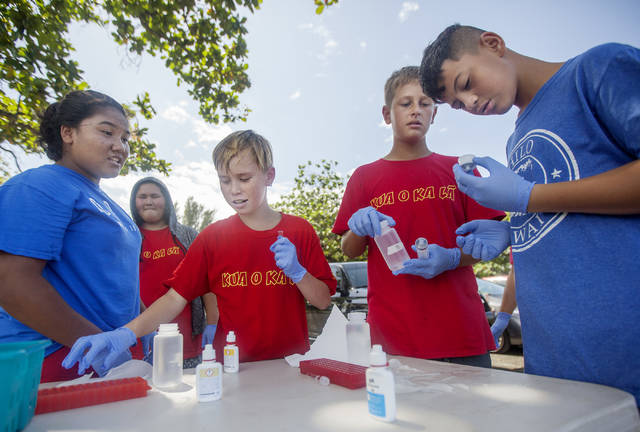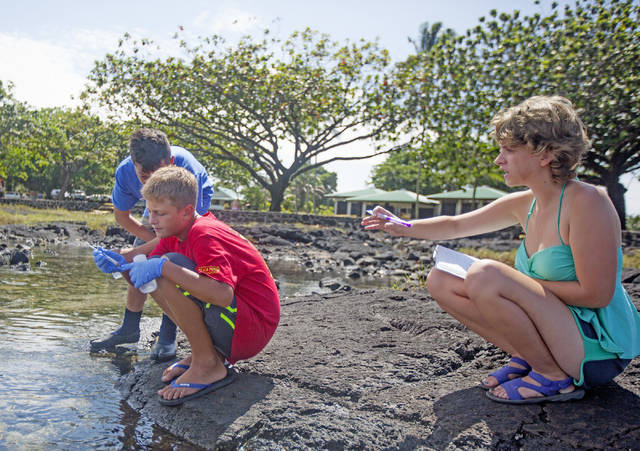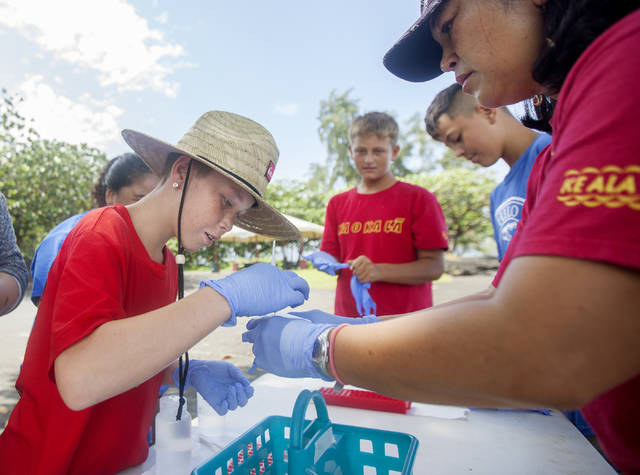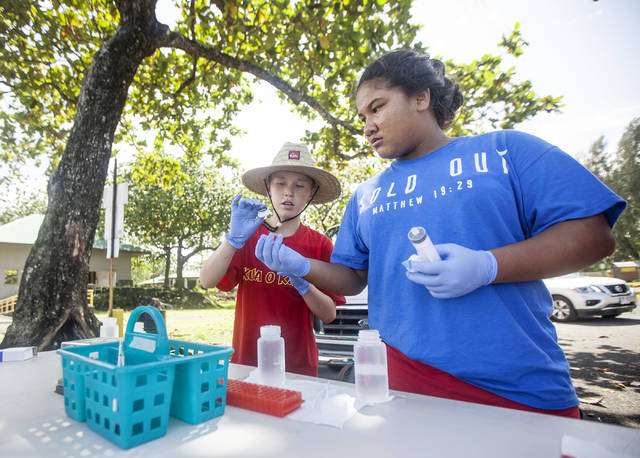KEAUKAHA — The tide pool at Onekahakaha Beach Park in Keaukaha appeared fairly empty Monday, but ask the Kua O Ka La New Century Public Charter School students who were taking water samples and they’d tell you otherwise: It was
KEAUKAHA — The tide pool at Onekahakaha Beach Park in Keaukaha appeared fairly empty Monday, but ask the Kua O Ka La New Century Public Charter School students who were taking water samples and they’d tell you otherwise: It was full of environmental DNA.
“It’s cool just experiencing what’s in the water,” said 15-year-old Kua O Ka La student Stacy Mattos-Kaluau, as she siphoned the contents of a sample through a plastic syringe that morning. “It’s like, you’re swimming in this place, and the water looks so clear until you test it and you find out all these things.”
Environmental DNA, or eDNA, is sloughed off by fish and other organisms. It includes mucus, waste, scales and other cells. It allows scientists to learn what’s been present in a habitat and gauge population numbers, among other things, without needing to see or collect the actual organism.
Mattos-Kaluau and about 30 of her fellow students are getting a hands-on opportunity this school year to learn about eDNA. They’re participating in a one-year eDNA study with the Oceanic Institute of Hawaii Pacific University on Oahu.
Each month, the Kua O Ka La students are collecting water samples, filtering them for eDNA and then preserving them, at Onekahakaha as well as coastal spots in Miloli‘i and Puna. Samples eventually will be sent to the Oceanic Institute for assessment to learn what — and how many — invertebrates, plants and vertebrates are present at each spot.
The school plans to post some of the results, once available, online.
Kua O Ka La is a Hawaiian-focused charter school with a main campus at Pu‘ala‘a in Puna, next to Ahalanui warm pond, and a satellite campus in Miloli‘i. It’s the first school to partner with the Oceanic Institute for the eDNA research. The project is funded by a $25,000 grant from Hawaii Community Foundation’s Hawaii STEM Learning Partnership.
“It’s pretty interesting what you can learn and understand through this research,” said Kua O Ka La history and math teacher Kaimi Kaupiko on Monday. “It gives you a better understanding of what’s happening in the community and how it relates to climate change. We’re hoping to open the students horizon more about what’s happening in their ocean.”
“It’s allowing us to see what’s in the water at that location at that time,” added Shari Jumalon, lead teacher for Kua O Ka La’s online Hipu‘u Program. “It’s not like immediate gratification, where we’ll know exactly what’s in the water tomorrow, but (it’ll be) kind of like a nice snapshot of what’s going on.”
The process of collecting eDNA is an “emerging technology,” said Gary Karr, director of education and training at the Oceanic Institute, by phone Tuesday.
Karr said eDNA also gives researchers a way to look for trends and compare the biodiversity between different coastal areas. He hopes the grant project spurs some of the charter school students to pursue education and careers in related fields.
Kua O Ka La senior Graecin Beebe, 17, was recording results from water testing Monday as part of her senior project.
Students also were practicing testing the water at Onekahakaha for nitrates and ammonia, as well as checking the pH level.
“My favorite part is just being out here and knowing what the environment is going through and how it’s affected by things,” Beebe said as she scratched down results in her notepad. “For example, it’s cool to know if the coral are being affected by something and what’s wrong and stuff like that. It’s just being aware of what’s in the environment and what’s affecting things around you.”
Email Kirsten Johnson at kjohnson@hawaiitribune-herald.com.






